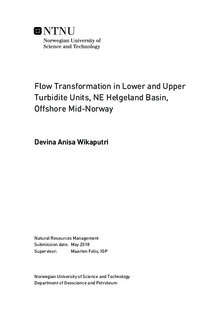Flow Transformation in Lower and Upper Turbidite Units, NE Helgeland Basin, Offshore Mid-Norway
Master thesis
Permanent lenke
http://hdl.handle.net/11250/2504050Utgivelsesdato
2018Metadata
Vis full innførselSamlinger
Sammendrag
Sediment transport towards the ocean floor is mainly by sediment gravity flows, either dominated by one flow process such as a slide, slump, debris flow or turbidity current, or more complex flows combining e.g. debris flows and turbidity currents (transitional flows). However, the expected product of a single gravity flow is not straightforward due to the possibility of flow transformation, which allows change of the original flow into a new type. Flow transformation is commonly observed as having a gradual interface between two different sediment gravity flow deposits that formed from different flow types (e.g. debrite and turbidite). Flow transformation has two end-members: (1) dense to dilute flow, and (2) dilute to dense flow, where each consists of a continuum of processes. The resulting deposits often look similar, which can result in misleading interpretation. Therefore, there is a need to study the distinguishing characteristics of the two end-members, which is looked at here.
This research studies the Upper Permian to Lower Triassic Turbidite Units from the NE Helgeland Basin, offshore mid Norway. Two cores, 6611/09-U-01 and 6611/09-U-02, were drilled through these successions. Previous work by Bugge et al. (2002) divided the successions into two units: (1) Lower Turbidite Unit and (2) Upper Turbidite Unit. The objective of this work is to study the depositional processes of these two units, in terms of flow transformation. Facies and facies associations were determined through detailed description of the cored succession and thin section microscopy.
Based on the observations, 14 main lithofacies were defined according to the grain size, texture, and sedimentary structures. The facies were combined into facies associations, showing that the successions include four transitional flow deposits: (1) debrite encased in low density turbidites, (2) alternating dense material and mixed debrite, (3) high density turbidite debrite couplet, and (4) High density turbidite debrite low density turbidite.
